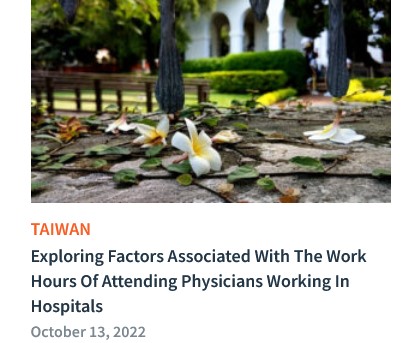
臺大公衛學院為加強宣導本院教師之學術成果,進而提升本院國際能見度,由張睿詒老師之撰寫以下列文章投稿至ASPPH Friday Letter.
該文目前已刊登於 ASPPH Friday Letter, October 14, 2022
篇名:
Exploring Factors Associated with the Work Hours of Attending Physicians Working in Hospitals
本所張睿詒老師為第四作者兼通訊作者

Abstract
Background
Long work hours for physicians not only harm the health of physicians, but also endanger patient safety. Compared with resident physicians, attending physicians—especially hospital-employed attending physicians—assume more responsibilities but has not gotten enough attention. The purpose of this study was to explore whether a hospital’s geographic location and emergency care responsibility might influence the number of hours worked.
Methods
The respondents of 2365 attending physicians from 152 hospitals in the 2018 survey of Taiwan physician work hours were used as the data source. The total work hour per week and its components, the regular scheduled shift and three types of on-call shifts, were used as outcome variables. Hospital geographic location and emergency care responsibility were the independent variables. The multilevel random effect model was employed to examine the study objective after adjusting for clinical specialty, hospital teaching status, and ownership.
Results
The average number of total working hours was 69.09 hours per week; the regular scheduled shift was account for 75% of total work hours. The results showed the total work hours were only varied by the level of hospital’s emergency care responsibility. However, the results also demonstrated the hours of duty shifts were varied by hospital’s geographic location and emergency care responsibility. The results of the multilevel random effect model revealed that the hospital’s emergency care responsibility was the factor consistently associated with attending physician’s work hour, no matter the total work hours or its composition.
Conclusion
In this study, we explored how a hospital’s location and its level of emergency care responsibility were associated with physicians’ work hours for each type of shift. Our findings offer an opportunity to review the rationality of physician workforce allocation, and financial incentives and administrative measures could be the next steps for balancing the work hours of attending physicians.
